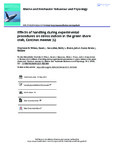Effects of handling during experimental procedures on stress indices in the green shore crab, <i>Carcinus maenas</i> (L)
| dc.contributor.author | Wilson, CH | |
| dc.contributor.author | Nancollas, SJ | |
| dc.contributor.author | Rivers, ML | |
| dc.contributor.author | Spicer, John | |
| dc.contributor.author | McGaw, IJ | |
| dc.date.accessioned | 2022-11-07T11:54:04Z | |
| dc.date.available | 2022-11-07T11:54:04Z | |
| dc.date.issued | 2021-05-13 | |
| dc.identifier.issn | 1023-6244 | |
| dc.identifier.issn | 1029-0362 | |
| dc.identifier.uri | http://hdl.handle.net/10026.1/19868 | |
| dc.description.abstract |
Stress due to handling is often an unavoidable feature of experimental investigations. In some cases, appropriate settling times are not considered, and as such, physiological responses caused by handling may become additive with those of experimental treatments. This study investigated the effect of different handling procedures on the acute physiological responses of green shore crab (Carcinus maenas). Handling, such as would occur during transport around a research facility or transfer during experimental procedure, was designated as light (10 min emersion) or severe (10 min emersion with shaking). Oxygen consumption (MO2) and haemolymph glucose and haemolymph L-lactate concentrations were elevated post-handling, the magnitude of the change related to the severity of handling stress. Glucose and L-lactate concentrations peaked within 1 h and returned to basal levels within 6 h, but MO2 remained elevated for 10 h, reflecting the additional energy required to oxidize L-lactate and replenish energy reserves. Differences between light and severe handling treatments showed that vibration (shaking) was a major contributor to the stress response, rather than the experimental emersion. This was confirmed in a second experiment where crabs were handled without emersion, and MO2 remained elevated for 14 h. In this experiment, the most pronounced increase in MO2 and metabolic parameters occurred in crabs that were physically touched and moved rapidly from the holding to experimental tanks. Here the touch, as well as vibration and visual stimuli, provoked a fight-flight response in the crabs. Stress responses were also evident in crabs gently transferred by containers. The fact that transferring crabs with no physical touching and minimal visual and vibrational stimuli still evoked a stress response, albeit less pronounced, supports a recommendation that crustaceans should be left to settle in the apparatus for at least 12 h after handling before experimental procedures are initiated. | |
| dc.format.extent | 65-86 | |
| dc.language | en | |
| dc.language.iso | en | |
| dc.publisher | Informa UK Limited | |
| dc.subject | Carcinus maenas | |
| dc.subject | handling stress | |
| dc.subject | glucose | |
| dc.subject | L-lactate | |
| dc.subject | oxygen consumption | |
| dc.title | Effects of handling during experimental procedures on stress indices in the green shore crab, <i>Carcinus maenas</i> (L) | |
| dc.type | journal-article | |
| dc.type | Journal Article | |
| plymouth.author-url | https://www.webofscience.com/api/gateway?GWVersion=2&SrcApp=PARTNER_APP&SrcAuth=LinksAMR&KeyUT=WOS:000649943400002&DestLinkType=FullRecord&DestApp=ALL_WOS&UsrCustomerID=11bb513d99f797142bcfeffcc58ea008 | |
| plymouth.issue | 2 | |
| plymouth.volume | 54 | |
| plymouth.publication-status | Published | |
| plymouth.journal | Marine and Freshwater Behaviour and Physiology | |
| dc.identifier.doi | 10.1080/10236244.2021.1923369 | |
| plymouth.organisational-group | /Plymouth | |
| plymouth.organisational-group | /Plymouth/Faculty of Science and Engineering | |
| plymouth.organisational-group | /Plymouth/Faculty of Science and Engineering/School of Biological and Marine Sciences | |
| plymouth.organisational-group | /Plymouth/REF 2021 Researchers by UoA | |
| plymouth.organisational-group | /Plymouth/REF 2021 Researchers by UoA/UoA07 Earth Systems and Environmental Sciences | |
| plymouth.organisational-group | /Plymouth/Research Groups | |
| plymouth.organisational-group | /Plymouth/Research Groups/Marine Institute | |
| plymouth.organisational-group | /Plymouth/Users by role | |
| plymouth.organisational-group | /Plymouth/Users by role/Academics | |
| dcterms.dateAccepted | 2021-04-24 | |
| dc.rights.embargodate | 2022-11-8 | |
| dc.identifier.eissn | 1029-0362 | |
| dc.rights.embargoperiod | Not known | |
| rioxxterms.versionofrecord | 10.1080/10236244.2021.1923369 | |
| rioxxterms.licenseref.uri | http://www.rioxx.net/licenses/all-rights-reserved | |
| rioxxterms.type | Journal Article/Review |


